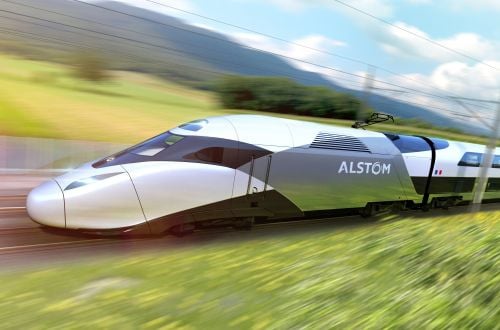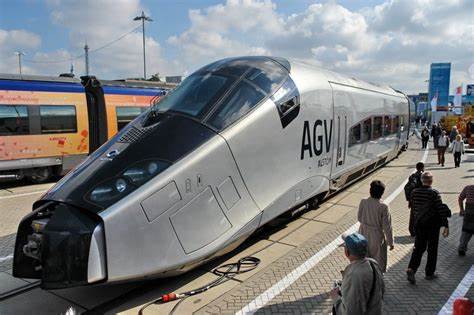1. Deutsche Bahn ICE: 350 km/h (Germany)
The ICE (Intercity-Express) is a German high-speed train of the top class. Its developers are Siemens and Bombardier known as global engineering leaders. The ICE can go as fast as 350 km/h for its maximum speed. Although, they can go for speeds of up to 330 km/h in some high-speed lines. Like the route between Frankfurt and Cologne, in order to prevent delays. Yet, the ICE 3 series have discovered even more capabilities as it was tested. Under acceleration classes 403 and 406 reached the record-breaking speed of 368 km/h.

ICE 3 is a set of classes including 403, 406, or 407, also known altogether as ICE 3, ICE 3M, New ICE 3, and ICE 3neo respectively. These world-class trainsets have raised the bar for high-speed travel in Europe surpassing the earlier definitions of high-speed travel in Europe, and hence, offering a different dimension to the travel experience of passengers.
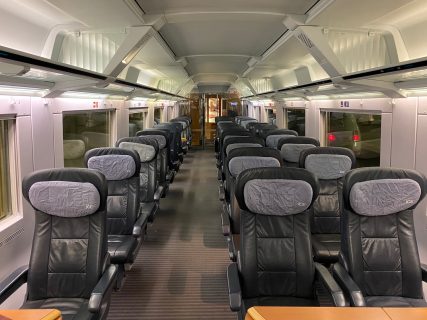
The ICE3 just not its impressive speed, but also made it possible for the cross-border connectivity to happen. It conducts its operation in international routes and covering neighboring countries including the Netherlands, Belgium, and France. This well-developed network has opened European cities up to unprecedented high-speed rail connections, thus becoming Europe’s most valuable asset for the development of a high-speed rail infrastructure.
2. SNCF TGV: 320 km/h (France)
The TGV of SNCF with its remarkable speed records, high-tech engineering and civil network possesses all that a true leader is made of. It has been a precedent to the steady development of high-speed rail as a major transport mode in Europe.

The Renfe Class 103 or Siemens Velaro is also known as the flagship of the Spanish high-speed-rail-network. It has been the backbone of the Spanish high-speed rail. Renfe, the State of Spanish railway operator, is the Class 103’s engine. The AVE (Alta Velocidad Española), popular as a high-speed service, is its backbone.
One of the fastest trains in Europe, the Renfe AVE can reach operating speeds of up to 310 km/h. Also, its records-breaking performance reaches a new height. In 2006, while conducting preliminary runs, the S103 trainset reached a record-breaking Maximo of 403.7 km/h. This became the new speed record for Spanish rail vehicles.
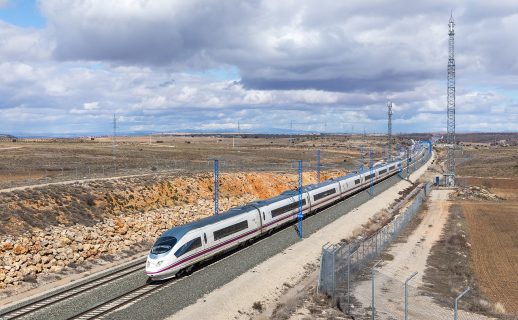
The arrival of the AVE in the country has transformed the way of travel between major cities, bringing a complete revolution to the people’s method of movement from one city to another. The high-speed rail system has seen incredible growth with cities like Madrid, Barcelona and Seville connected by rapid train between them, thus cutting down travel time thereby, encouraging more and more people to travel by rail.
The Siemens-Renfe alliance has been a main factor behind the success of the Renfe AVE as it combines the power of advanced technology from Siemens with Renfe’s operational expertise. The Renfe configuration is exclusive. It consists two half-trains with four carriages each. electric system for traction that is independent for each half-train and a high-voltage line all along the length of the train.
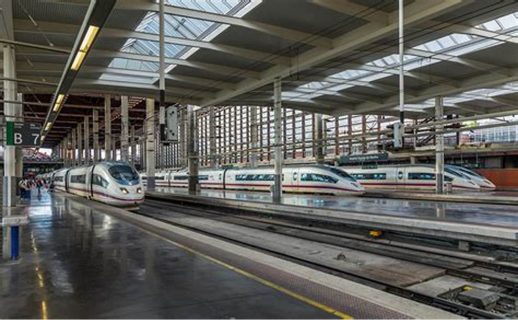
The Frecciarossa or the ETR1000 class is a high-speed train. It has become a symbol of Italy’s efforts to realize sustainable and efficient means of transport. Co-created by two well-known engineering firms, Hitachi Rail Italy and Alstom. The Frecciarossa is in management by Trenitalia, a state railway company from Italy.
The Frecciarossa train is capable of reaching the maximum speed of 300 km/h. It is one of the fastest in Europe. Nevertheless, its powers go beyond, considering that during its testing in 2015, one of the ETR1000 trainsets clocked the amazing speed of 389 km/h. Hence, proving out how advanced the technology and engineering are behind its design.
The Frecciarossa, which means “Red Arrow” in Italian, has been a symbol of high-speed travel. This has changed how people move between the major cities in Italy. The fast and comfortable train has brought further the urban centers in Rome, Venice and Naples in quick time making scheduled train the most convenient and even an attractive option for both long-distance travelers and commuters.
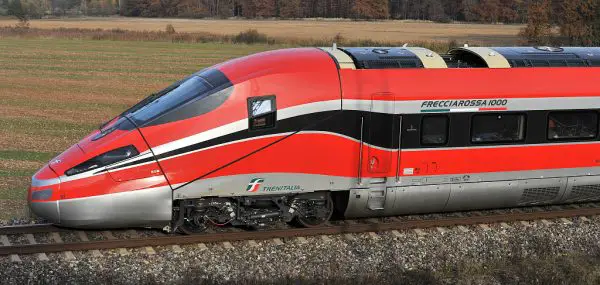
5. Italo AGV: 300 km/h (Italy)
The AGV (Automotrice à grande vitesse) is a non-tilting electric multiple-unit train. It was built by renowned French engineering company Alstom. In addition, it has introduced a whole new level of high-speed train travel in Italy. The AGV is managed by Nuovo Trasporto Viaggiatori (NTV), a private Italian railway company trading as Italo that is a competitor to the state-owned Trenitalia.
The AGV has a maximum operational speed of 300 km/h and is one of the fastest trains in Europe. Nevertheless, its capabilities do not stop there because during testing it managed to hit a record top speed of 360 km/h, which is a clear demonstration of the advanced technology and engineering expertise invested in it.
Italy counts 25 AGV trains in its fleet for many of the routes such as Turin–Milan–Bologna, Rome–Venice, and Bologna–Florence–Rome–Naples. The presence of AGVs on these main routes has changed the way Italians travel, offering a comfortable, efficient, and environmentally friendly alternative to air and road transportation.
Alstom’s factories in Savigliano, Italy, and La Rochelle, France, have been key in the assembly of the AGV trainsets. The trains come in 7-car and 11-car configurations, with lengths of 132m and 200m respectively, capable of taking a large number of passengers in the well-equipped and spacious cars.
The Italo AGV, with its great speed, advanced technology and focus on sustainability, is changing the Italian high-speed rail market by offering passengers higher levels of comfort and efficiency, linking some of the country’s most famous destinations.
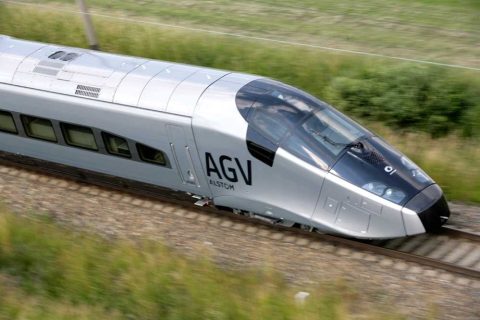
The Eurostar Velaro is the British Rail Class 374. It is a cutting-edge electric multiple-unit passenger train. It has transformed European cross-border high-speed travel. Siemens, a leading engineering company, produces the Eurostar Velaro at the Krefeld plant in Germany. Moreover, it is a core component of the Eurostar network linking major cities in the UK, France, Belgium and the Netherlands.
The Eurostar Velaro which can reach a top speed of 320 km/h is one of the fastest trains in Europe. This is a result of the powerful traction system. It consists of eight identical but independent traction converter units and 64 axles of which 32 are driven. The train’s traction system is intended to operate smoothly on both 25kV AC and 1.5kV/3kV DC voltages systems. Therefore, enabling it to cover the various rail lines within the Eurostar network.
The Eurostar Velaro is a 16-car giant, which can accommodate 900 people. It has impressive length and passenger accommodation as well as top-notch security features. The train carries a special fire extinguishing equipment and fireproof doors. Moreover, it has the ability to operate for 30 minutes on its onboard power supply to exit the tunnel in the event of an emergency.
The success of Eurostar Velaro has not only laid the foundation for cross-border travel but also deepened the bonds between nations. The Eurostar Velaro’s contribution to sustainable transportation has been crucial in making high-speed rail a viable alternative as well as an attractive option for travelers thereby playing a pivotal role in reducing the environmental impact of short-haul air travel.
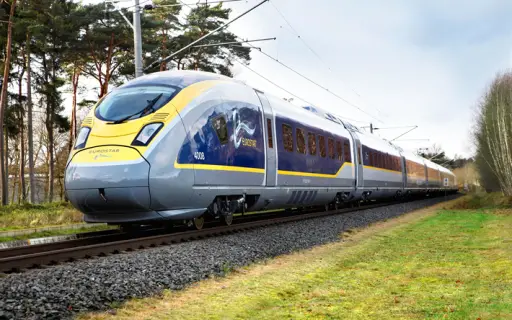
The Renfe Talgo 250, is also in reference as the Alvia. It is a high-speed train that has served as the catalyst for the spread of Spain’s high-speed rail network. Operated by Renfe, the national railway operator of Spain, the Talgo 250 is used for the Alvia service. It links the main cities across the whole nation.
The Talgo 250 was manufactured through a collaborative effort between two engineering giants, the Spanish company Talgo and the Canadian company Bombardier. It is a unique and innovate train that integrates the best of cutting-edge technology and versatility. It is a dual-gauge, dual-voltage and hybrid train, able to reach 250 km/h, one of the fastest trains in Europe.
One of the main features of the Talgo 250 is the hybrid power configuration. It enables the train to run on routes where some parts are not electrified. Thus, ensuring a smooth and convenient trip for passengers. This flexibility has made the Talgo 250 able to link cities like Madrid to Coruña, Ferrol and Vigo, increasing the reach of high-speed rail services in Spain.
A single Talgo 250 trainset consists of 13 cars, including two electric power cars, two diesel-power cars, and nine Talgo VII tilting passenger coaches. Moreover, the passenger cars consist of 6 second class coaches, 2 first class coaches, and a dining car with a capacity to accommodate 265 passengers. This layout guarantees a pleasant and roomy travel for passengers. In addition, a variety of amenities and services for their enjoyment.
Thanks to its innovative design, versatility and impressive speed, the Renfe Talgo 250 is an integral part of the high-speed rail network of Spain. Hence, links cities and communities around the nation and provides sustainable transportation.
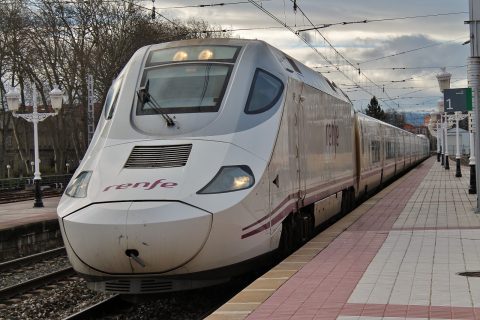
8. Renfe Pendolino: 250 km/h (Spain)
The Avant Class 114 is also the S-114 for short. It is a high-speed train that has been paramount in the Renfe’s strategy. Aims at expanding the high-speed rail network to cover mid-distance routes. Operated by Renfe, the national railway operator of Spain, the Avant Class 114 is a part of the Avant network. Therefore, it enables high-speed rail services for shorter trips.
It was developed by two of the most famous train manufacturers. The Spanish company, Construcciones y Auxiliar de Ferrocarriles (CAF), and the French company, Alstom. The Avant Class 114 is a train with advanced technology that combines speed and comfort. These trains, referred to as Pendolinos because of their tilting mechanism, can reach a top speed of up to 250 km/h, which is one of the highest speed of trains in Europe.
The trains consist of four single-voltage electric railcars, which have a total length of 108 meters. Each train can hold up to 237 passengers and has one access seat per train to accommodate low mobility passengers.
The Avant Class 114 is working on several important routes in Spain. Among them is the Madrid-Segovia-Valladolid high-speed line. As well as trains from Madrid to Puertollano and from Barcelona to Lérida. These routes have been carefully chosen to provide mid-sized cities and regions with high-speed rail access. Thus, extending the advantages of high-speed transport to a greater number of communities.
By its high speed, advanced technology, and the focus on the passenger comfort, the Renfe Avant Class 114 has become an essential part of Spain’s high-speed rail network. Therefore, it connects big cities with smaller destinations. Consequently, it offers a sustainable and efficient mode of transport for shorter trips.
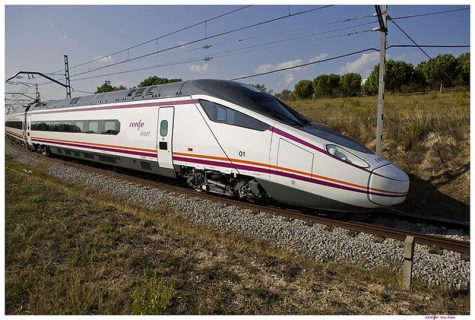
9. SBB Giruno: 250 km/h (Switzerland)
The RABe 501, better known as the Giruno, is a revolutionary electric-multiple unit high-speed train that has become a symbol of innovation and accessibility in the Swiss rail sector. In operation by the Swiss Federal Railways (SBB), the Giruno is mostly in deployment on the Trans-Alpine route that links Milan in Italy with the Swiss cities of Basel and Zurich.
With a maximum speed of 250 km/h excluding Switzerland, the Giruno is one of the fastest trains in Europe. Nevertheless, its greatest achievement is in its accessibility features. The Giruno is the world’s first single-decker, low-floor high-speed train providing step-free access throughout all areas of the train. This unique design provides ease of boarding and disembarkation to the passengers, including those with disabilities, therefore making it one of the most accessible high-speed trains in Europe.
The train has signal amplifiers for 3G/4G cellular networks, power-outlets for both Swiss and international plugs, and large luggage compartments, providing an enjoyable and connected journey for passengers. Each Giruno trainset consists of 11 cars, 202 meters long. The train can seat 403 passengers, with 117 seats in 1st class and 286 in 2nd class. Two trains can also be in links together to increase the passenger capacity to over 800, which will cater to the increasing demand for high-speed rail travel in Switzerland and beyond.
Using its advanced technology, remarkable speed and dedication to accessibility, the SBB Giruno has set a new benchmark for high-speed rail travel not only in Switzerland but in Europe and worldwide.
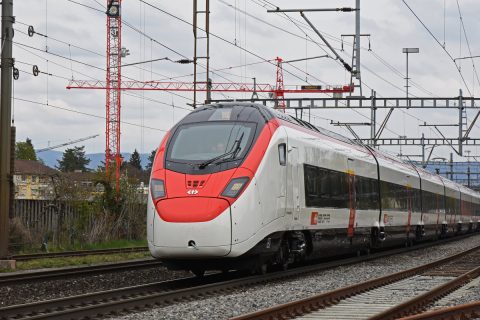
The Sapsan (or Velaro RUS EVS) is a cutting-edge electric high-speed rail. It has become a true symbol of Russia’s readiness to bring its railways into the era of modern technology. It is built by the world’s engineering giant, Siemens, as a part of the popular Velaro family. Thus, Sapsan is in operation by Russian Railways or RZHD, which is the Russian national rail company.
Reaching the speed of 250 km/h, Sapsan is the fastest train among those which are currently in operation domestically. Additionally, its capabilities reach far ahead as it has managed to reach a speed of 290 km/h when it was being tested. Highlighting the sophisticated technology, and the engineering skill that has set its design apart.

Sapsan trainsets usually does a 10-car guise, making the total number of passengers to be 600. The interior of the train has a design to make your journey a restful and comfortable one, with all the necessary modern amenities and sufficient seating. With its modern exterior appearance, and aerodynamic features, the Sapsan is able to sail through the air with little resistance facilitating its high speed, and superb performance.
Featuring high speed, latest technologies, and adaptability to Russian specific train system, it is the essence of progress and accomplishment in the field of the Russian transport sector that has established it as a symbol of progress and achievement in Russian rail transportation and is leading the way in the development of high-speed train travel.
Conclusion
The success of high-speed rail in Europe can be attributed to the collaborative endeavors of different manufacturers, operators and nations. The companies such as Siemens, Alstom, Bombardier, and Talgo have developed and produced trains which are capable of achieving high speeds. Operators like SNCF, Deutsche Bahn, and Renfe have been the key players in bringing these high-speed services to life. In addition to connecting major cities from all over the world.
Europe’s high-speed rail network is steadily growing. It includes the latest technologies and innovative approaches; the future of high-speed travel looks increasingly promising. Therefore, these top ten fastest intercity trains in Europe, not only mean a great engineering achievement. But also, the result of efforts of nations, companies, and individuals to transform the way we move in these days, bridging people and communities.
